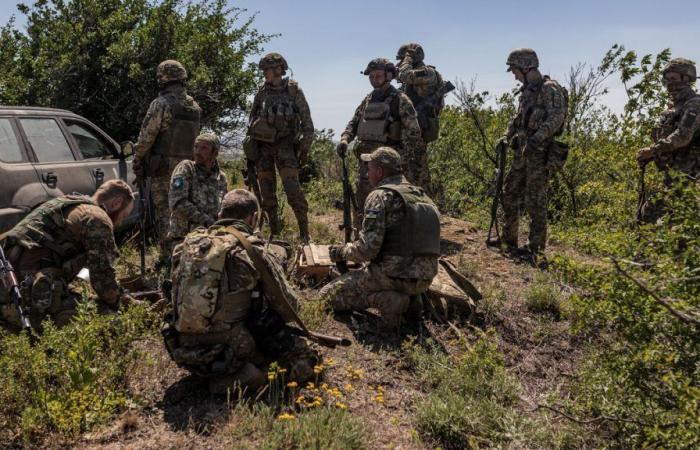Reading time: 5 minutes
Three million blocks of stone, 60 million bricks and 70,000 feet of sandstone. This is what the construction of the citadel of Lille, designed by Vauban and completed in 1670 on the orders of Louis XIV, would have required. In the heart of the northern city, the “queen of citadels” (as Vauban himself had named her), then protected Flanders taken back by France from Spain. Since 2005, it has now hosted the headquarters of the Rapid Reaction Corps-France (CRR-Fr), facing Russia. This French corps-level headquarters, compliant with North Atlantic Treaty Organization (NATO) standards, can command a national or multinational land force comprising up to 120,000 soldiers.
To access this true pentagonal “city within a city”, whose buildings combine Flemish and French styles, you must first cross the vast garden that surrounds it, pass a chip shop and the Cita-Parc family amusement park, take the avenue of the 43rd infantry regiment, cross the royal gate and the bridge that overlooks the moat, pass through the successive security checks and finally arrive at the parade ground to reach the conference room.
On May 29 and 30, 2024, the Lille citadel hosted the annual Vauban Sessions seminar. Co-organized by the CRR-Fr and the strategic intelligence firm CEIS, a subsidiary of Forward Global (formerly Avisa Partners), this year it focused on the following theme: “Ordering in the era of high intensity: vision 2030”. The expression “high intensity”, omnipresent in strategic studies since the Russian invasion of Ukraine in February 2022, designates the confrontation of armies which have significant and comparable firepower, involving significant human losses. and material. Western armies, which have mainly fought jihadist insurgencies over the past two decades, have until now been largely unprepared.
The event was open to the press, but subject to the Chatham House rule: no disclosure of who said what. As part of several panels, the seminar mainly welcomed officers from several countries of the North Atlantic Alliance (France, United Kingdom, United States, Poland), whether they are employed by their national army, by the NATO or spent in the private sector. Many subjects were raised, through the prism of the war in Ukraine. The first concerned the extreme vulnerability of men and equipment in a high-intensity context and the need for camouflage.
Become invisible
Several officers noticed a “increased battlefield transparency” dissipating the “fog of war”, with the development of drones, satellite imagery and the omnipresence of electronic warfare: detection and espionage of transmissions, jamming and counter-jamming. Any group of men and materials that does not take the trouble to conceal itself – visually and in terms of its electromagnetic emissions – therefore sees its life expectancy drop instantly. “Everything that emits or receives waves is threatened with destruction” by an artillery, drone-kamikaze or missile strike, recalls a soldier.
The Ukrainian army has adapted to this new reality. The transmission antennas are several hundred meters away from people and vehicles, using extension cables. In some cases, telephone lines and even couriers (human messengers) are preferred. Command posts (CPs) must be discreet and hidden as much as possible in places, such as urban areas, where the waves they emit will be “diluted” (drowned) in the midst of other radiation: telephone communications, Wi-Fi networks, radio waves, etc. Soldiers must also demonstrate discretion in the field and the greatest discipline in the use of their smartphones, tablets and computers, which are also tools in the service of victory.
This information has been well integrated by NATO countries which, during recent exercises, have trained to reduce the size and visibility of command posts, limit signal emissions, “hiding in the electromagnetic spectrum” and… disciplining soldiers regarding the use of their smartphones.
Decentralized command and innovation
Ukraine’s successes are also attributed to the decentralization of command, which is based in particular on Delta software. Any vehicle equipped with a Starlink antenna – considered the “backbone” of the Ukrainian command and control (C2) system – can become a command post (CP). This prevents the army from finding itself paralyzed if an important PC is destroyed. Furthermore, thanks to the Delta application available on smartphones, soldiers can access a lot of information such as video feeds from drones, data relating to missions, etc.
Even more surprising: software like GIS Arta – originally a simple application combining mapping and a ballistic calculator to adjust gunners’ strikes – lists enemy targets, communicates their presence to nearby Ukrainian units and then lets them decide which one is the one. better placed to attack them. A true “Uber of artillery”. This decentralization makes it possible to leave, as far as possible, the initiative to the soldiers closest to the field rather than deciding in a too vertical way. The use of artificial intelligence (AI) to generate targets and “propose” them to soldiers – and to make all internal processes more efficient – is of particular interest to NATO and its armies.
This also underlines that the functioning of the Ukrainian army relies on a large number of technologies from the civilian world or developed outside of major arms programs (and their consequent deadlines), whether by companies, volunteers or units. soldiers themselves. On the command and control (C2) side, it is Starlink for communications, Signal for certain communications (sometimes WhatsApp, despite the risk of Russian espionage) and the aforementioned software such as Delta and GIS Arta. On the weapons side, these are drones cobbled together in workshops all over Ukraine on the basis of civilian technologies, which can strike the Russians, including deep within their territory.
A multi-domain war
However, more sophisticated weapons, like those already obtained or requested by Ukrainian President Volodymyr Zelensky from his Western allies, remain necessary. “You need low-tech to saturate enemy defenses and high-tech to [les] enter”specifies an officer.
Several participants stressed the need to focus on proven technologies that can be deployed quickly and allow the existing components of an army to work more effectively together, for example by «dronisant» F-16 fighter jets using AI, as the company Shield AI is currently doing. Without abandoning major weapons programs, despite their propensity to “cost three times too much” and to be delivered with “fifteen years late” . The finalization of the Franco-German-Spanish SCAF combat aircraft project (future air combat system) is therefore not expected before 2040.
A final lesson from Ukraine concerns “domain stacking”. While Western militaries have long believed that the only battlefield of the future would be cyberspace, the Russian-Ukrainian conflict is playing out in a multitude of physical and virtual spaces: on land, on and under the sea, in the air. , in space, in electromagnetic signals, on the internet, etc. The intangible fields are interconnected. “Intelligence spots breaches, electronic warfare opens them, cyber exploits them”summarizes a general.
But the material and the immaterial are also connected: we can send special forces to sabotage the enemy’s electronic warfare capabilities (radars, jammers), its internet infrastructure or destroy its communications satellites with missiles. And conversely, we can use electronic warfare, cyberattacks and online influence operations to diminish our offensive capabilities. High-intensity warfare therefore takes place everywhere and at the same time. Are we prepared?






